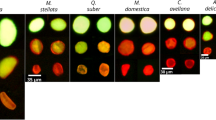Summary
Methods currently available for evaluating pollen quality in vitro include, (a) tests of germinability; (b) tests of the stainability of the vegetative cell contents; (c) tests for enzyme activity, and (d) the fluorochromatic procedure (FCR), which tests principally the integrity of the plasmalemma of the vegetative cell. Using germinability in vitro as a standard, a comparison has been made between histochemical methods of classes (b), (c) and (d) in application to various pollens, immature, mature, and treated in ways known to affect viability and membrane state. Predictably, the lowest correlation was obtained with tests of stainability. The highest was given by the FCR, which generally provided an excellent guide to potential germinability. The FCR procedure is subject to various limitations, however, (a) A high correlation between FCR and germinability can only be expected when mature, ripe pollen is used; with immature pollen, the FCR will predict excessively high potential germinability. (b) The FCR may also predict a higher potential level of pollen function than in vitro germinability when the germination medium is sub-optimal. In this situation, however, it will generally give a better guide to fertilising capacity, (c) The FCR is not a test of pollen viability. Like germinability in vitro, it can yield a negative score with pollen which is nevertheless capable of functioning. For example, false negatives will be obtained with some species if the pollen is not properly pre-conditioned by rehydration before testing, an important point in monitoring stored pollen. The paper includes a brief discussion of the rationale of pollen testing.
Similar content being viewed by others
References
Cook SA, Stanley RG (1960) Tetrazolium chloride as an indicator of pine pollen germinability. Silvae Genet 9:134–136
Darlington CD, La Cour LF (1950) The handling of chromosomes. George Alien & Unwin, London
Delmer DP, Mils SE (1969) A technique for the assay of enzymes in intact plant cells in the presence of DMSO. Plant Physiol 44:153–155
Dickinson PB (1967) Permeability and respiratory properties of germinating pollen. Physiol Plant 20:118–127
Greenway H, Munns R (1980) Mechanisms of salt tolerance in non-halophytes. Ann Rev Plant Physiol 31:149–190
Heslop-Harrison J, Heslop-Harrison Y (1970) Evaluation of pollen viability by enzymatically induced fluorescence: intracellular hydrolysis of fluorescein diacetate. Stain Technol 45:115–120
Janssen AWB, Hermsen JGT (1976) Estimating pollen fertility in Solarium species and hybrids. Euphytica 25:577–586
King JR (1960) The peroxidase reaction as an indicator of pollen viability. Stain Technol 35:225–227
Linskens HF, Kroh M (1967) Inkompatibilität der Phanerogamen. In: Ruhland W (ed) Encyclopedia of plant physiology, vol 18. Springer, Berlin Heidelberg New York, pp 506–530
Rotman B, Papermaster BW (1966) Membrane properties of living mammalian cells as studied by enzymatic hydrolysis of fluorogenic esters. Proc Natl Acad Sci USA 55:134–141
Sass JE (1964) Botanical microtechnique. Iowa State University Press, Ames, Iowa
Sharadakov VS (1940) Cited in Stanley RG, Linskens HF “Pollen: biology, biochemistry and management” (1974). Springer, Berlin Heidelberg New York
Shivanna KR, Heslop-Harrison J (1981) Membrane state and pollen viability. Ann Bot 47:759–770
Shivanna KR, Heslop-Harrison J, Heslop-Harrison Y (1983) Heterostyly in Primula. 3. Pollen water economy: a factor in the intramorph incompatibility response. Protoplasma (in press)
Stanley RG, Linskens HF (1974) Pollen: biology, biochemistry and management. Springer, Berlin Heidelberg New York
Van Tieghem MP (1869) Recherches Physiologiques sur la végétation libre du pollen et de l'ovule et sur la fécondation directe des plantes. Ann Sci Nat Bot 12:312–328
Walden DB, Everett HL (1961) A quantitative method for the in vivo measurement of the viability of corn pollen. Crop Sci 1:21–25
Author information
Authors and Affiliations
Additional information
Communicated by H. F. Linskens
Rights and permissions
About this article
Cite this article
Heslop-Harrison, J., Heslop-Harrison, Y. & Shivanna, K.R. The evaluation of pollen quality, and a further appraisal of the fluorochromatic (FCR) test procedure. Theoret. Appl. Genetics 67, 367–375 (1984). https://doi.org/10.1007/BF00272876
Received:
Issue Date:
DOI: https://doi.org/10.1007/BF00272876




